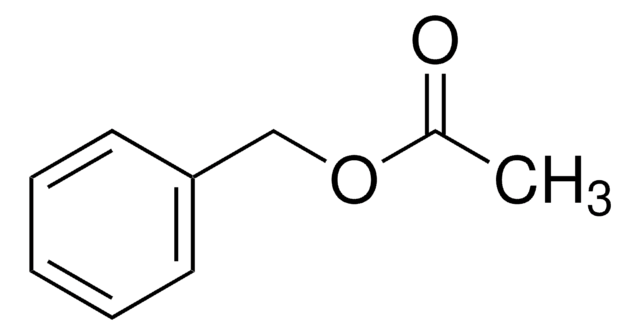08421
Benzyl alcohol
analytical standard
Synonym(s):
Benzenemethanol
About This Item
Recommended Products
grade
analytical standard
Quality Level
vapor density
3.7 (vs air)
vapor pressure
13.3 mmHg ( 100 °C)
3.75 mmHg ( 77 °C)
Assay
≥99.5% (GC)
autoignition temp.
817 °F
shelf life
limited shelf life, expiry date on the label
technique(s)
HPLC: suitable
gas chromatography (GC): suitable
refractive index
n20/D 1.539 (lit.)
n20/D 1.541
bp
203-205 °C (lit.)
mp
−16-−13 °C (lit.)
density
1.045 g/mL at 25 °C (lit.)
application(s)
environmental
food and beverages
format
neat
SMILES string
OCc1ccccc1
InChI
1S/C7H8O/c8-6-7-4-2-1-3-5-7/h1-5,8H,6H2
InChI key
WVDDGKGOMKODPV-UHFFFAOYSA-N
Looking for similar products? Visit Product Comparison Guide
General description
Application
- Wine samples by dichloromethane microextraction followed by gas chromatography-flame ionization detection (GC-FID).
- Uncased and cased tobaccos by stream distillation continuous extraction (SDE) followed by capillary GC or GC coupled with mass spectroscopy (MS).
- Dairy products by solid phase microextraction (SPME) followed by GC-MS.
- Scented products by reversed phase high performance liquid chromatography (HPLC) combined with diode array detector (DAD).
Other Notes
Recommended products
Signal Word
Warning
Hazard Statements
Precautionary Statements
Hazard Classifications
Acute Tox. 4 Inhalation - Acute Tox. 4 Oral - Eye Irrit. 2
Storage Class Code
10 - Combustible liquids
WGK
WGK 1
Flash Point(F)
213.8 °F - DIN 51758
Flash Point(C)
101 °C - DIN 51758
Personal Protective Equipment
Choose from one of the most recent versions:
Already Own This Product?
Find documentation for the products that you have recently purchased in the Document Library.
Customers Also Viewed
Protocols
US EPA Method 8270 (Appendix IX): GC Analysis of Semivolatiles on Equity®-5 (30 m x 0.25 mm I.D., 0.50 μm)
Our team of scientists has experience in all areas of research including Life Science, Material Science, Chemical Synthesis, Chromatography, Analytical and many others.
Contact Technical Service




